Change Management Analysis: A Case Study from University
VerifiedAdded on 2022/08/14
|5
|944
|11
Case Study
AI Summary
This case study analysis examines the implementation of a change management plan within an organization. It highlights the advantages and disadvantages of a top-down approach, focusing on employee commitment, resistance to change, and the roles of senior management. The analysis explores the importance of affective, normative, and continuance commitment and identifies key reasons for employee resistance, such as fear of job loss and poor communication. The role of the managing director as a facilitator is discussed, along with the involvement of regional managers and employees in the decision-making process. The assignment also references Palmer and colleagues' six images of change, suggesting how the case organization could have improved its change management strategy by incorporating these roles to ensure a successful implementation. The analysis emphasizes the need for effective communication and the importance of considering employee perspectives throughout the change process.
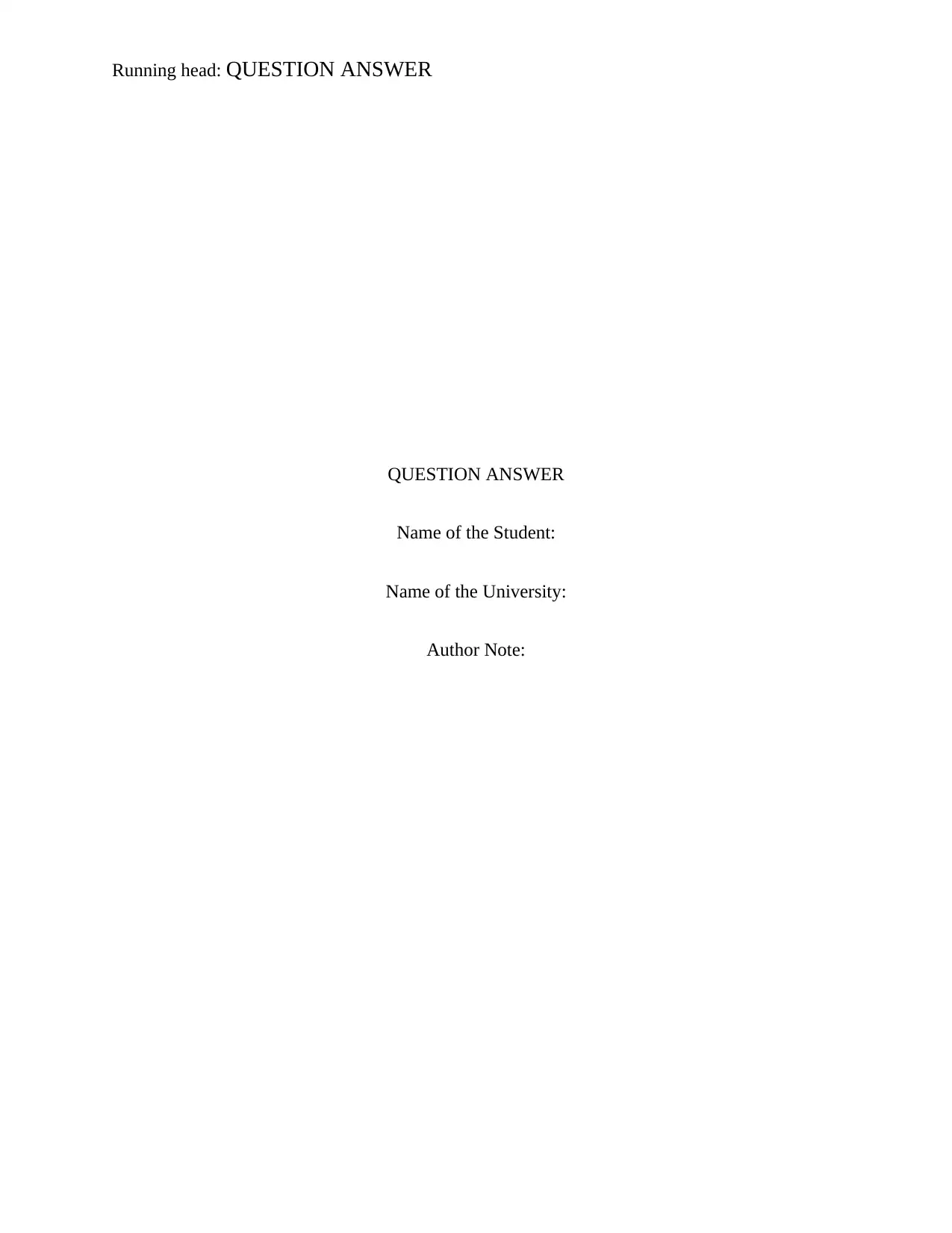
Running head: QUESTION ANSWER
QUESTION ANSWER
Name of the Student:
Name of the University:
Author Note:
QUESTION ANSWER
Name of the Student:
Name of the University:
Author Note:
Paraphrase This Document
Need a fresh take? Get an instant paraphrase of this document with our AI Paraphraser
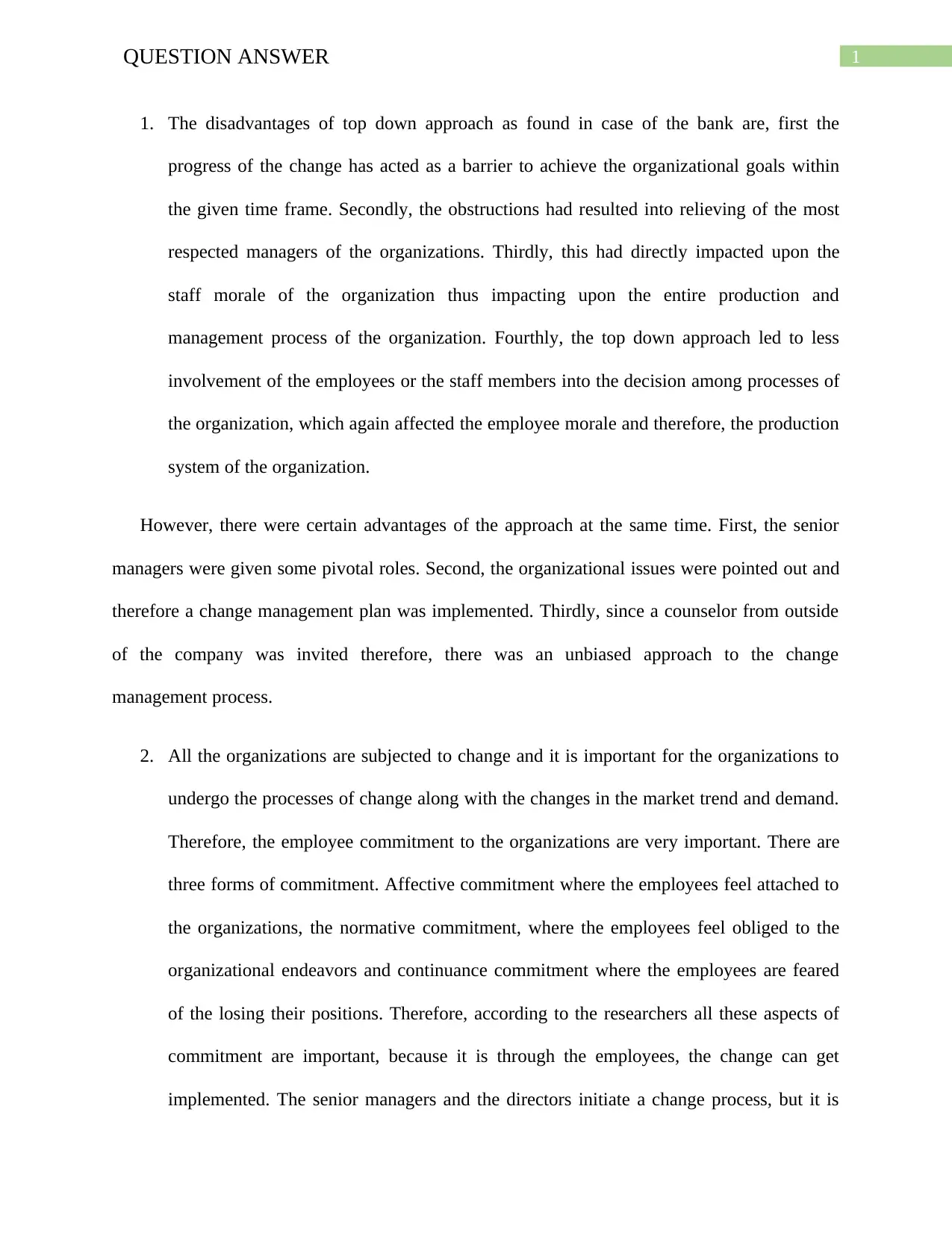
1QUESTION ANSWER
1. The disadvantages of top down approach as found in case of the bank are, first the
progress of the change has acted as a barrier to achieve the organizational goals within
the given time frame. Secondly, the obstructions had resulted into relieving of the most
respected managers of the organizations. Thirdly, this had directly impacted upon the
staff morale of the organization thus impacting upon the entire production and
management process of the organization. Fourthly, the top down approach led to less
involvement of the employees or the staff members into the decision among processes of
the organization, which again affected the employee morale and therefore, the production
system of the organization.
However, there were certain advantages of the approach at the same time. First, the senior
managers were given some pivotal roles. Second, the organizational issues were pointed out and
therefore a change management plan was implemented. Thirdly, since a counselor from outside
of the company was invited therefore, there was an unbiased approach to the change
management process.
2. All the organizations are subjected to change and it is important for the organizations to
undergo the processes of change along with the changes in the market trend and demand.
Therefore, the employee commitment to the organizations are very important. There are
three forms of commitment. Affective commitment where the employees feel attached to
the organizations, the normative commitment, where the employees feel obliged to the
organizational endeavors and continuance commitment where the employees are feared
of the losing their positions. Therefore, according to the researchers all these aspects of
commitment are important, because it is through the employees, the change can get
implemented. The senior managers and the directors initiate a change process, but it is
1. The disadvantages of top down approach as found in case of the bank are, first the
progress of the change has acted as a barrier to achieve the organizational goals within
the given time frame. Secondly, the obstructions had resulted into relieving of the most
respected managers of the organizations. Thirdly, this had directly impacted upon the
staff morale of the organization thus impacting upon the entire production and
management process of the organization. Fourthly, the top down approach led to less
involvement of the employees or the staff members into the decision among processes of
the organization, which again affected the employee morale and therefore, the production
system of the organization.
However, there were certain advantages of the approach at the same time. First, the senior
managers were given some pivotal roles. Second, the organizational issues were pointed out and
therefore a change management plan was implemented. Thirdly, since a counselor from outside
of the company was invited therefore, there was an unbiased approach to the change
management process.
2. All the organizations are subjected to change and it is important for the organizations to
undergo the processes of change along with the changes in the market trend and demand.
Therefore, the employee commitment to the organizations are very important. There are
three forms of commitment. Affective commitment where the employees feel attached to
the organizations, the normative commitment, where the employees feel obliged to the
organizational endeavors and continuance commitment where the employees are feared
of the losing their positions. Therefore, according to the researchers all these aspects of
commitment are important, because it is through the employees, the change can get
implemented. The senior managers and the directors initiate a change process, but it is
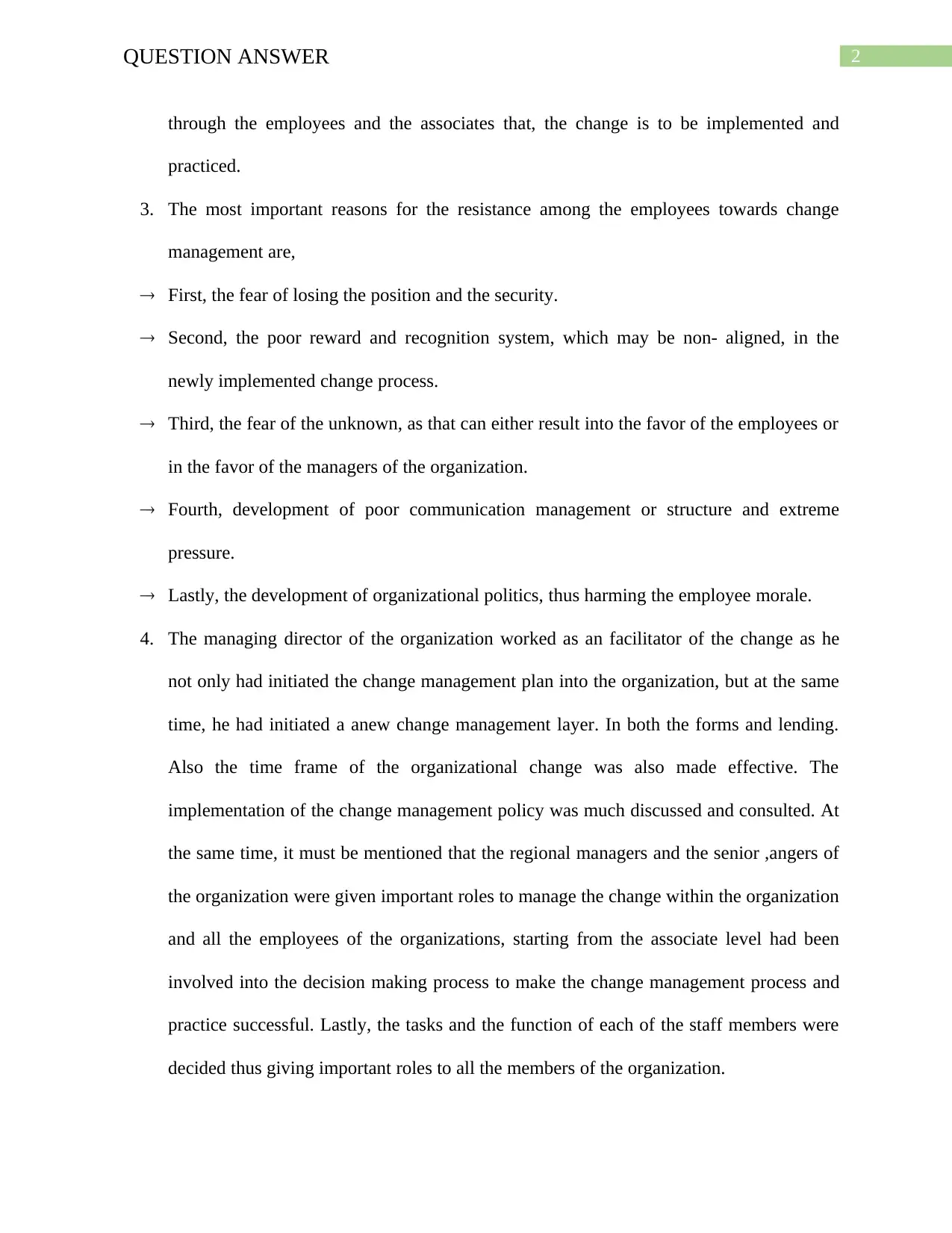
2QUESTION ANSWER
through the employees and the associates that, the change is to be implemented and
practiced.
3. The most important reasons for the resistance among the employees towards change
management are,
First, the fear of losing the position and the security.
Second, the poor reward and recognition system, which may be non- aligned, in the
newly implemented change process.
Third, the fear of the unknown, as that can either result into the favor of the employees or
in the favor of the managers of the organization.
Fourth, development of poor communication management or structure and extreme
pressure.
Lastly, the development of organizational politics, thus harming the employee morale.
4. The managing director of the organization worked as an facilitator of the change as he
not only had initiated the change management plan into the organization, but at the same
time, he had initiated a anew change management layer. In both the forms and lending.
Also the time frame of the organizational change was also made effective. The
implementation of the change management policy was much discussed and consulted. At
the same time, it must be mentioned that the regional managers and the senior ,angers of
the organization were given important roles to manage the change within the organization
and all the employees of the organizations, starting from the associate level had been
involved into the decision making process to make the change management process and
practice successful. Lastly, the tasks and the function of each of the staff members were
decided thus giving important roles to all the members of the organization.
through the employees and the associates that, the change is to be implemented and
practiced.
3. The most important reasons for the resistance among the employees towards change
management are,
First, the fear of losing the position and the security.
Second, the poor reward and recognition system, which may be non- aligned, in the
newly implemented change process.
Third, the fear of the unknown, as that can either result into the favor of the employees or
in the favor of the managers of the organization.
Fourth, development of poor communication management or structure and extreme
pressure.
Lastly, the development of organizational politics, thus harming the employee morale.
4. The managing director of the organization worked as an facilitator of the change as he
not only had initiated the change management plan into the organization, but at the same
time, he had initiated a anew change management layer. In both the forms and lending.
Also the time frame of the organizational change was also made effective. The
implementation of the change management policy was much discussed and consulted. At
the same time, it must be mentioned that the regional managers and the senior ,angers of
the organization were given important roles to manage the change within the organization
and all the employees of the organizations, starting from the associate level had been
involved into the decision making process to make the change management process and
practice successful. Lastly, the tasks and the function of each of the staff members were
decided thus giving important roles to all the members of the organization.
⊘ This is a preview!⊘
Do you want full access?
Subscribe today to unlock all pages.

Trusted by 1+ million students worldwide
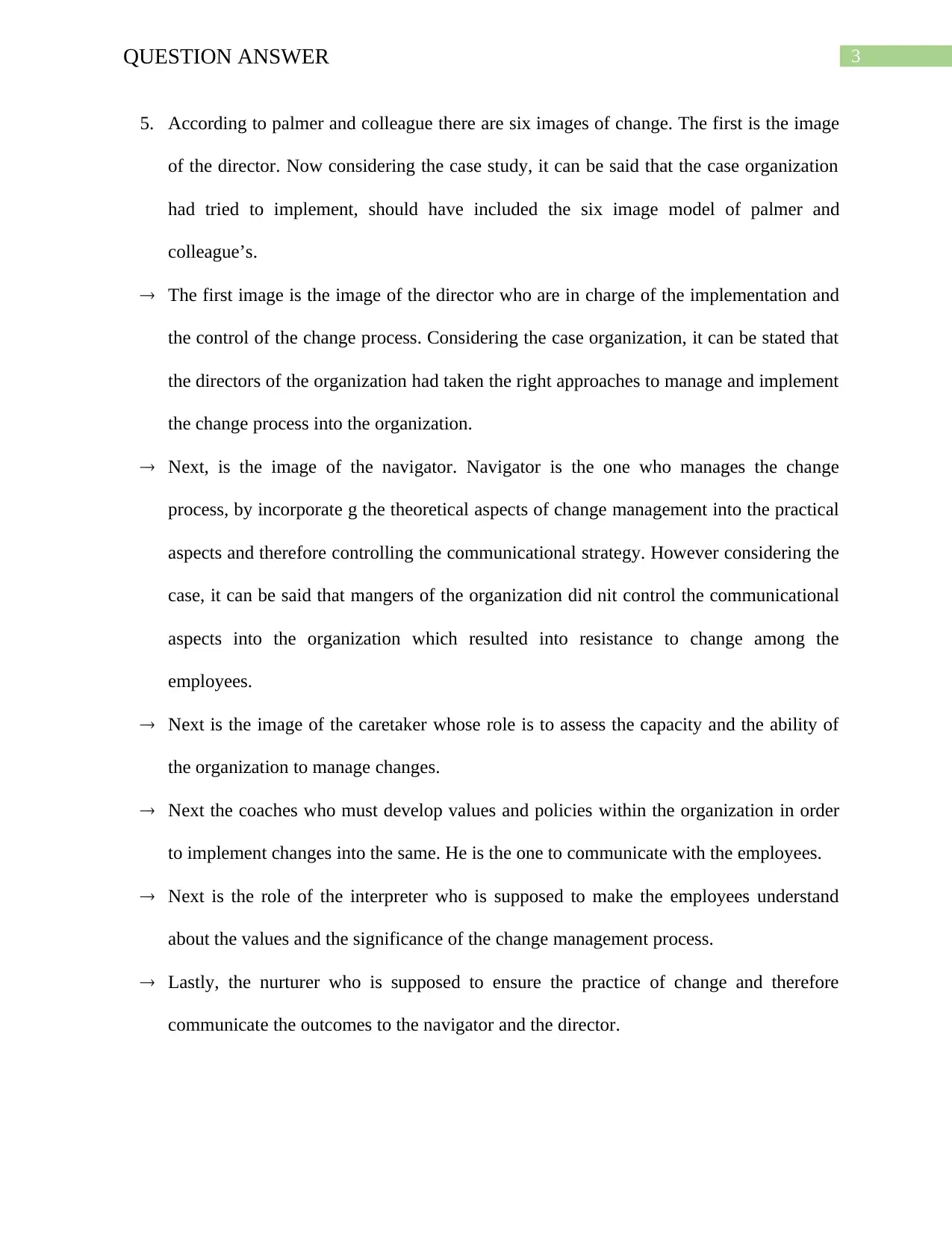
3QUESTION ANSWER
5. According to palmer and colleague there are six images of change. The first is the image
of the director. Now considering the case study, it can be said that the case organization
had tried to implement, should have included the six image model of palmer and
colleague’s.
The first image is the image of the director who are in charge of the implementation and
the control of the change process. Considering the case organization, it can be stated that
the directors of the organization had taken the right approaches to manage and implement
the change process into the organization.
Next, is the image of the navigator. Navigator is the one who manages the change
process, by incorporate g the theoretical aspects of change management into the practical
aspects and therefore controlling the communicational strategy. However considering the
case, it can be said that mangers of the organization did nit control the communicational
aspects into the organization which resulted into resistance to change among the
employees.
Next is the image of the caretaker whose role is to assess the capacity and the ability of
the organization to manage changes.
Next the coaches who must develop values and policies within the organization in order
to implement changes into the same. He is the one to communicate with the employees.
Next is the role of the interpreter who is supposed to make the employees understand
about the values and the significance of the change management process.
Lastly, the nurturer who is supposed to ensure the practice of change and therefore
communicate the outcomes to the navigator and the director.
5. According to palmer and colleague there are six images of change. The first is the image
of the director. Now considering the case study, it can be said that the case organization
had tried to implement, should have included the six image model of palmer and
colleague’s.
The first image is the image of the director who are in charge of the implementation and
the control of the change process. Considering the case organization, it can be stated that
the directors of the organization had taken the right approaches to manage and implement
the change process into the organization.
Next, is the image of the navigator. Navigator is the one who manages the change
process, by incorporate g the theoretical aspects of change management into the practical
aspects and therefore controlling the communicational strategy. However considering the
case, it can be said that mangers of the organization did nit control the communicational
aspects into the organization which resulted into resistance to change among the
employees.
Next is the image of the caretaker whose role is to assess the capacity and the ability of
the organization to manage changes.
Next the coaches who must develop values and policies within the organization in order
to implement changes into the same. He is the one to communicate with the employees.
Next is the role of the interpreter who is supposed to make the employees understand
about the values and the significance of the change management process.
Lastly, the nurturer who is supposed to ensure the practice of change and therefore
communicate the outcomes to the navigator and the director.
Paraphrase This Document
Need a fresh take? Get an instant paraphrase of this document with our AI Paraphraser
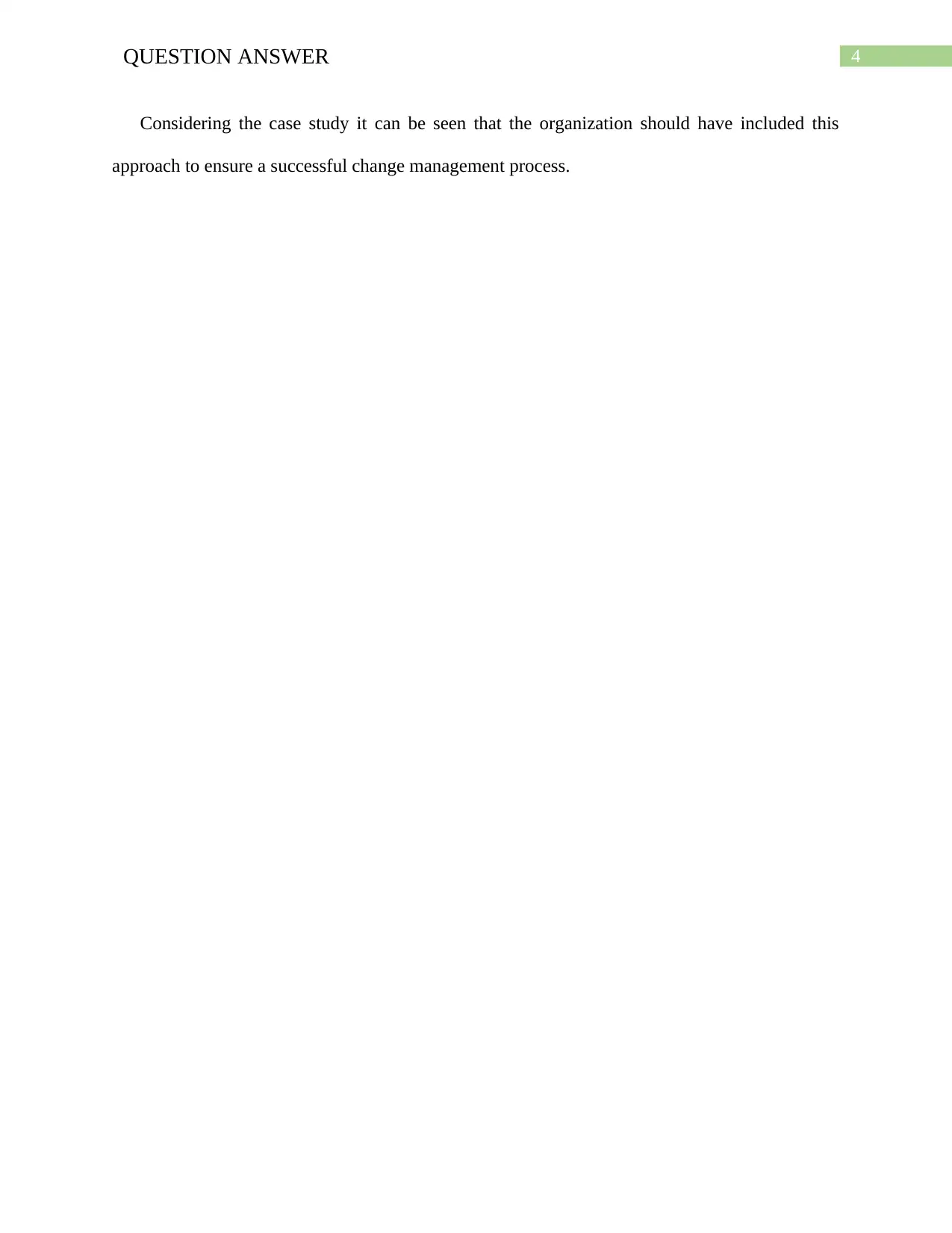
4QUESTION ANSWER
Considering the case study it can be seen that the organization should have included this
approach to ensure a successful change management process.
Considering the case study it can be seen that the organization should have included this
approach to ensure a successful change management process.
1 out of 5
Related Documents
Your All-in-One AI-Powered Toolkit for Academic Success.
+13062052269
info@desklib.com
Available 24*7 on WhatsApp / Email
![[object Object]](/_next/static/media/star-bottom.7253800d.svg)
Unlock your academic potential
Copyright © 2020–2025 A2Z Services. All Rights Reserved. Developed and managed by ZUCOL.





